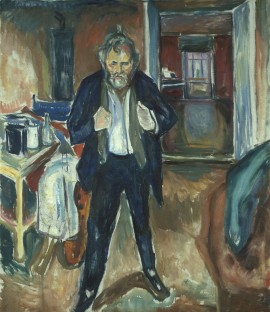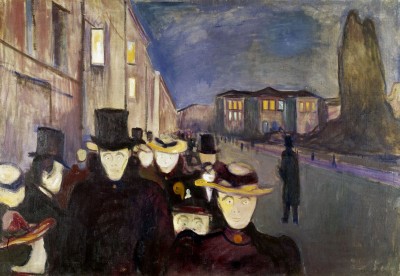It’s been heady times of late for Norway’s most famous artist, Edvard Munch. Long hailed abroad but seemingly ignored at home, Munch’s art itself is finally getting massive display, through a major exhibition opening this weekend at both the Munch Museum and the National Gallery in Oslo and, later, in a new, much larger museum that won city government support on Wednesday.

The exhibition, mounted in connection with the 150th anniversary of Munch’s birth in the rural community of Løiten, is being billed as “the most comprehensive” ever shown in Norway, or probably outside Norway as well. More than 270 of his works will be on display at both museums in a joint project that will feature most of his best-known paintings but also many that have rarely if ever been seen before.
“We mostly want to celebrate Edvard Munch, but we also want to raise knowledge, curiosity and enthusiam for Munch’s life and art both locally, nationally and internationally,” said Stein Olav Henrichsen, director of the Munch Museum in the working class district of Tøyen on Oslo’s east side.
The Munch Museum has held constant exhibitions of Munch’s work since it opened in 1963, 19 years after the City of Oslo inherited Munch’s own vast, personal collection when he died in 1944. It was arguably too small, however, even when it opened, and has never been able to display more than a fraction of the city’s inherited collection of 1,100 paintings along with lithographs, 4,700 drawings, 500 moulds, 2,240 books and notebooks, documents, photographs, letters and furniture. The vast majority has been stored away in cellars, where there’s also been fears they were being damaged by dampness.

The National Gallery in downtown Oslo, meanwhile, has long had a room devoted to Munch’s art, where a version of the famous Skriket (The Scream) is on permanent display. Now, for the next four-and-a-half months, it will display a much larger collection of Munch’s works created between 1882 and 1903. Works created between 1904 and 1944 will be on display at the Munch Museum, with the entire joint exhibition set up in chronological order and structured by themes in Munch’s art.
The goal, according to museum officials, is to present the largest possible exhibit of Munch’s art and career, both from the city’s and state’s collections and from private collectors all over the world who have sent their Munch creations to Oslo. The exhibit has been made possible through grants from the Munch Museum’s longtime sponsor Idemitsu Petroleum of Japan along with the Airport Express Train (Flytoget), Statkraft and a local bank foundation led by DNB. Newspaper Aftenposten reported recently that Idemitsu alone has contributed around NOK 75 million to the Munch Museum over the past 20 years, at a time when city funding for maintenance and operations was hard to come by.

Hallstein Bjercke, the city government leader of culture and business issues from the Liberal Party (Venstre), denies the city has shirked its responsibility for its Munch legacy over the years. “We’re committed to Munch,” Bjercke wrote in a commentary in newspaper Dagsavisen last month. “Munch is one of the world’s great artists, not just Norway’s.” He claims that despite recent budget cuts, overall funding for Munch-related projects has increased over the past 10 years, and the city government worked hard to win support on the City Council for a new Munch Museum.
While much of the city’s collection will need to be stored away again when the jubilee exhibit closes on October 13, Munch enthusiasts were greatly cheered this week when news broke that after years of quarreling, city politicians had settled on a location and design for a new, much more spacious Munch Museum in a landmark building to be constructed on Oslo’s eastern waterfront next to the Opera House.
It means that much of Munch’s priceless legacy will finally be available for public view on a much more regular basis after decades of what some art lovers consider shabby treatment by the city. Museum staff, who’ve also been subject to budget cuts and threatened layoffs because of other financial problems at the Munch Museum, say they’ll ultimately be able to show works the public has never seen before. The collection including many additional Munch works that’s held by the Stenersen Museum in Oslo’s Vika district will also move into the new museum, due to open in 2018. Stenersen’s Munch collection, also willed to the city, has been stored away for security reasons.
It’s hoped that the new exhibition and the new landmark building for the museum will also attract far more visitors than the Munch Museum at Tøyen has over the years. Norwegian officials hope Norwegians themselves will develop a new appreciation for their homegrown legendary artist, like his millions of fans already have around the world.
The new “Munch 150” exhibit was opening for press and dignitaries Friday and Saturday, and to the public on Sunday June 2. It will be open daily from 10am to 5pm at both museums, 10am to 7pm on Thursdays.
Several special events will also be held in conjunction with the exhibit, including a music festival next weekend at the Munch Museum organized by Norwegian trumpet star Tine Thing Helseth. She’ll literally be blowing life into the exhibit, and will be joined by Norwegian pianist Leif Ove Andsnes, cellist Truls Mørk and entertainer Ingrid Bjørnov.
Views and News from Norway/Nina Berglund
Please support our news service. Readers in Norway can use our donor account. Our international readers can click on our “Donate” button:

